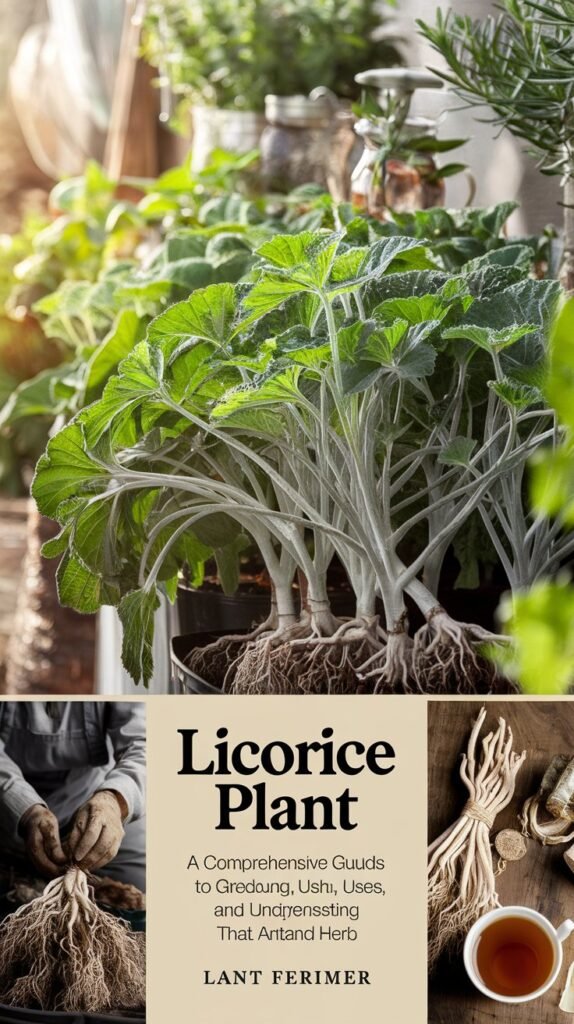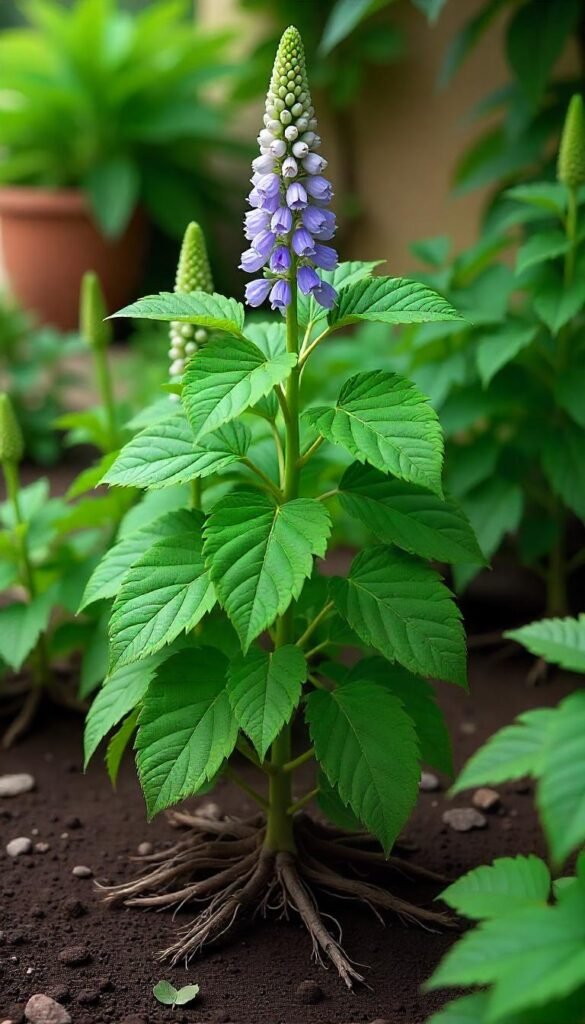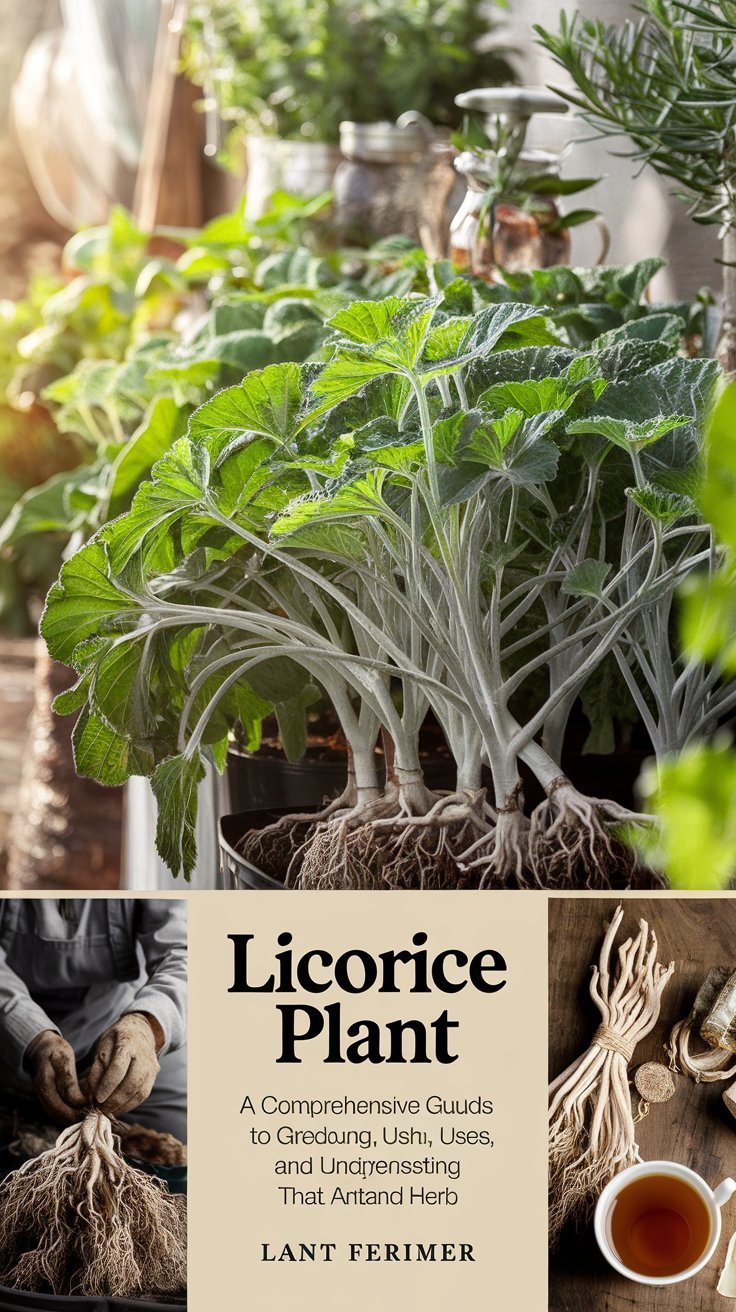Discover the versatile Licorice plant in our 2024 guide. Learn about its cultivation, medicinal uses and culinary applications. Explore the rich history and modern benefits of this ancient herb. Perfect for gardeners and herbal enthusiasts.
The licorice plant (Glycyrrhiza glabra) is a remarkable herb with a rich history dating back thousands of years. Known for its distinctive sweet flavor and numerous medicinal properties, this versatile plant has been used in traditional medicine, confectionery, and even cosmetics. In this comprehensive guide, we’ll explore the fascinating world of the licorice plant, from its cultivation and uses to its potential benefits and precautions.

As a botanist and herbalist with over two decades of experience studying and cultivating medicinal plants, I’m excited to share my knowledge about this ancient and valuable herb. Let’s delve into the multifaceted world of the licorice plant!
Understanding the Licorice Plant

Botanical Characteristics
Scientific Name: Glycyrrhiza glabra Family: Fabaceae (legume family) Native Range: Mediterranean region, parts of Asia
The licorice plant is a perennial herb that can grow up to 3-7 feet tall. It’s characterized by:
- Compound leaves with 9-17 leaflets
- Pale blue to violet flowers
- Long, extensive root system
2024 Update: Recent genetic studies have identified new subspecies of licorice, expanding our understanding of its diversity.
Fun Fact: The word “glycyrrhiza” comes from the Greek words “glykys” (sweet) and “rhiza” (root).
Historical Significance
Licorice has been used for thousands of years:
- Ancient Egyptians used it in tea as a cure-all drink
- Chinese traditional medicine has employed it for centuries
- It was found in King Tutankhamun’s tomb, intended for the afterlife
2024 Insight: New archaeological discoveries are shedding light on licorice’s role in ancient trade routes.
Cultivating Licorice
Growing Conditions
Licorice plants thrive in:
- Full sun to partial shade
- Well-draining, fertile soil
- USDA Hardiness Zones 6-11
2024 Trend: Climate change is expanding licorice’s potential growing range, with successful cultivation now possible in previously unsuitable areas.
Planting and Care
- Propagation: Usually done through root cuttings or seeds
- Planting Time: Spring or fall
- Spacing: 3-4 feet apart
- Watering: Regular watering, especially during dry spells
- Fertilization: Annual application of compost or balanced organic fertilizer
Pro Tip: Licorice plants can be invasive. Consider growing them in containers or using root barriers.
Harvesting
- Roots are typically harvested after 3-4 years of growth
- Best done in the fall after the foliage dies back
- Carefully dig up roots, leaving some for regrowth
2024 Innovation: New sustainable harvesting techniques are being developed to ensure long-term viability of wild licorice populations.
Uses of Licorice
Medicinal Applications
Licorice has been used to treat various conditions:
- Digestive issues (ulcers, heartburn)
- Respiratory problems (sore throat, bronchitis)
- Skin conditions (eczema, psoriasis)
- Hormonal imbalances
2024 Research: Recent studies are exploring licorice’s potential in managing metabolic disorders.
Caution: Always consult with a healthcare professional before using licorice for medicinal purposes.
Culinary Uses
Licorice is used in various foods and beverages:
- Confectionery (candies, sweets)
- Beverages (teas, liquors)
- Flavoring agent in some cuisines
2024 Trend: Craft breweries are experimenting with licorice in creating unique beer flavors.
Industrial Applications
- Tobacco industry (as a flavoring agent)
- Cosmetics (in some skincare products)
- Fire retardant in some specialized applications
2024 Innovation: Sustainable licorice-based plastics are being developed as eco-friendly alternatives.
Health Benefits and Precautions
Potential Benefits
- Anti-inflammatory properties
- Immune system support
- Stress reduction
- Liver health support
2024 Research Focus: Studies are investigating licorice’s potential role in supporting gut microbiome health.
Precautions and Side Effects
While beneficial, licorice can have side effects:
- High blood pressure
- Low potassium levels
- Interactions with certain medications
Important: Pregnant women and those with specific health conditions should avoid licorice. Always consult a healthcare provider before use.
Licorice in Modern Herbal Medicine
Standardized Extracts
Modern herbal medicine often uses standardized licorice extracts:
- DGL (Deglycyrrhizinated Licorice): Used for digestive issues
- Whole Root Extract: For respiratory and immune support
2024 Update: New extraction methods are improving the efficacy and safety profile of licorice supplements.
Integrative Medicine Approaches
Licorice is increasingly being integrated into holistic health practices:
- Used in combination with other herbs for synergistic effects
- Incorporated into stress management protocols
2024 Trend: Personalized herbal medicine protocols are incorporating genetic testing to optimize licorice use for individual patients.
Sustainability and Conservation
Wild Harvesting Concerns
The popularity of licorice has led to concerns about overharvesting in some regions.
2024 Initiative: Global efforts are underway to establish sustainable wild-harvesting guidelines for licorice.
Cultivation Efforts
To reduce pressure on wild populations:
- Encourage home cultivation
- Support sustainable commercial farming practices
- Develop licorice alternatives for non-medicinal uses
Pro Tip: By growing your own licorice, you contribute to conservation efforts and ensure a personal supply of this valuable herb.
Embracing the Sweet Root
The licorice plant, with its rich history and myriad uses, continues to fascinate and benefit us in the modern world. From its role in traditional medicine to its potential in addressing contemporary health challenges, licorice remains a valuable botanical ally.
As we look to the future, responsible cultivation, sustainable harvesting, and ongoing research will ensure that this ancient herb continues to sweeten our lives in more ways than one. Whether you’re a gardener, herbalist, or simply curious about natural remedies, the licorice plant offers a world of possibilities to explore.
For more information on herbal medicine and plant conservation, visit resources like the American Botanical Council or United Plant Savers. Happy exploring, and may the sweet wisdom of licorice enrich your herbal journey!
For more gardening tips and plant care guides, visit usagardenhub.com


1 thought on “Licorice Plant : A Comprehensive Guide to Growing, Using and Understanding This Ancient Herb”